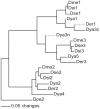Slip-sliding away: serial changes and homoplasy in repeat number in the Drosophila yakuba homolog of human cancer susceptibility gene BRCA2
- PMID: 20543987
- PMCID: PMC2882388
- DOI: 10.1371/journal.pone.0011006
Slip-sliding away: serial changes and homoplasy in repeat number in the Drosophila yakuba homolog of human cancer susceptibility gene BRCA2
Abstract
Several recent studies have examined the function and evolution of a Drosophila homolog to the human breast cancer susceptibility gene BRCA2, named dmbrca2. We previously identified what appeared to be a recent expansion in the RAD51-binding BRC-repeat array in the ancestor of Drosophila yakuba. In this study, we examine patterns of variation and evolution of the dmbrca2 BRC-repeat array within D. yakuba and its close relatives. We develop a model of how unequal crossing over may have produced the expanded form, but we also observe short repeat forms, typical of other species in the D. melanogaster group, segregating within D. yakuba and D. santomea. These short forms do not appear to be identical-by-descent, suggesting that the history of dmbrca2 in the D. melanogaster subgroup has involved repeat unit contractions resulting in homoplasious forms. We conclude that the evolutionary history of dmbrca2 in D. yakuba and perhaps in other Drosophila species may be more complicated than can be inferred from examination of the published single genome sequences per species.
Conflict of interest statement
Figures





Similar articles
-
Molecular evolution of a Drosophila homolog of human BRCA2.Genetica. 2009 Nov;137(2):213-9. doi: 10.1007/s10709-009-9376-9. Epub 2009 Jun 25. Genetica. 2009. PMID: 19554456 Free PMC article.
-
Divergence between Drosophila santomea and allopatric or sympatric populations of D. yakuba using paralogous amylase genes and migration scenarios along the Cameroon volcanic line.Mol Ecol. 2001 Mar;10(3):649-60. doi: 10.1046/j.1365-294x.2001.01225.x. Mol Ecol. 2001. PMID: 11298976
-
Landscape of standing variation for tandem duplications in Drosophila yakuba and Drosophila simulans.Mol Biol Evol. 2014 Jul;31(7):1750-66. doi: 10.1093/molbev/msu124. Epub 2014 Apr 7. Mol Biol Evol. 2014. PMID: 24710518 Free PMC article.
-
Genetics of a difference in pigmentation between Drosophila yakuba and Drosophila santomea.Evolution. 2002 Nov;56(11):2262-77. doi: 10.1111/j.0014-3820.2002.tb00150.x. Evolution. 2002. PMID: 12487356
-
The Drosophila mitochondrial genome.Oxf Surv Eukaryot Genes. 1984;1:1-35. Oxf Surv Eukaryot Genes. 1984. PMID: 6400770 Review.
References
-
- Venkitaraman AR. Cancer susceptibility and the functions of BRCA1 and BRCA2. Cell. 2002;108:171–182. - PubMed
-
- Gundmundsdottir K, Ashworth A. The roles of BRCA1 and BRCA2 and associated proteins in the maintenance of genomic stability. Oncogene. 2006;25:5864–5874. - PubMed
-
- Miki Y, Swensen J, Shattuck-Eidens D, Futreal PA, Harshman K, et al. A strong candidate for the breast and ovarian cancer susceptibility gene BRCA1. Science. 1994;266:66–71. - PubMed
-
- Nathanson KN, Wooster R, Weber BL. Breast cancer genetics: what we know and what we need. Nature Med. 2001;7:552–556. - PubMed
Publication types
MeSH terms
Grants and funding
LinkOut - more resources
Full Text Sources
Molecular Biology Databases
Research Materials
Miscellaneous

